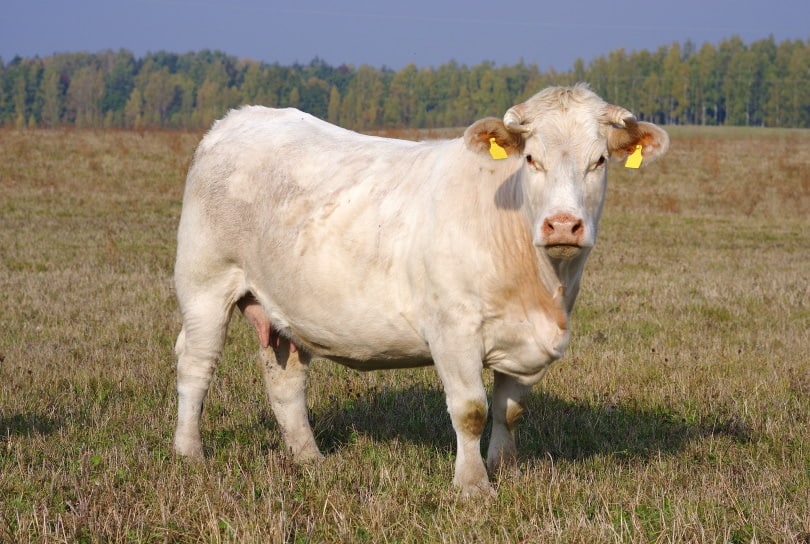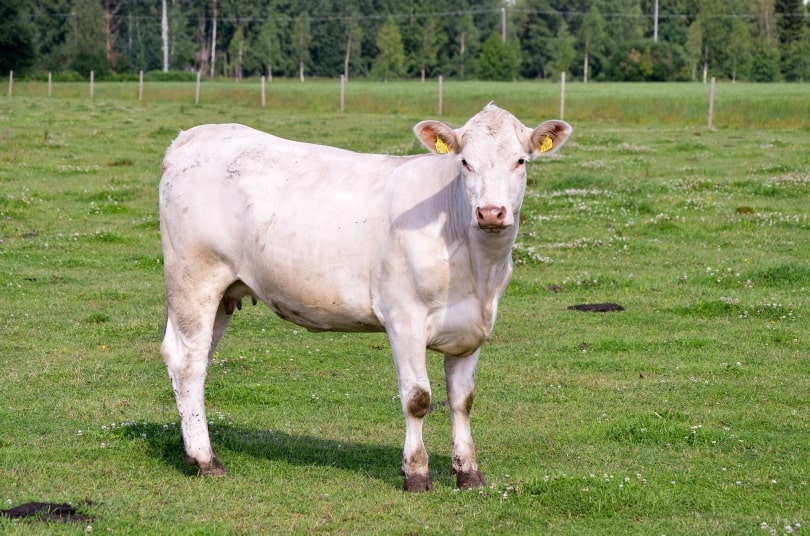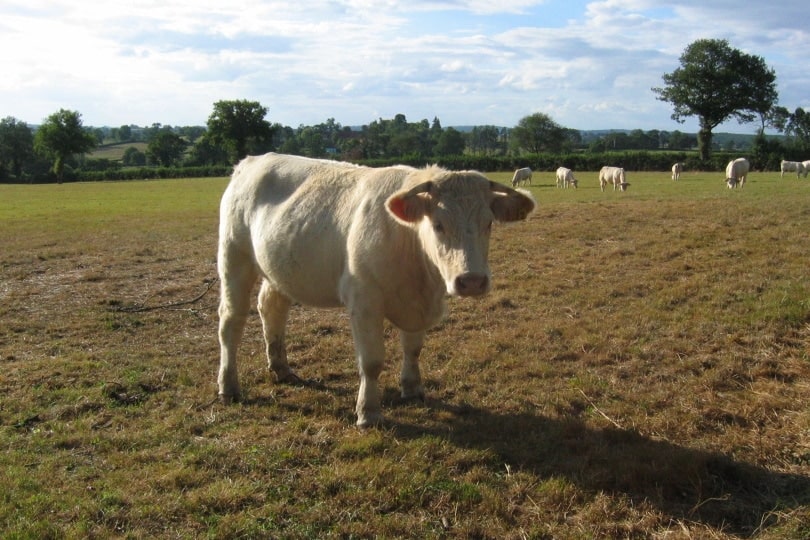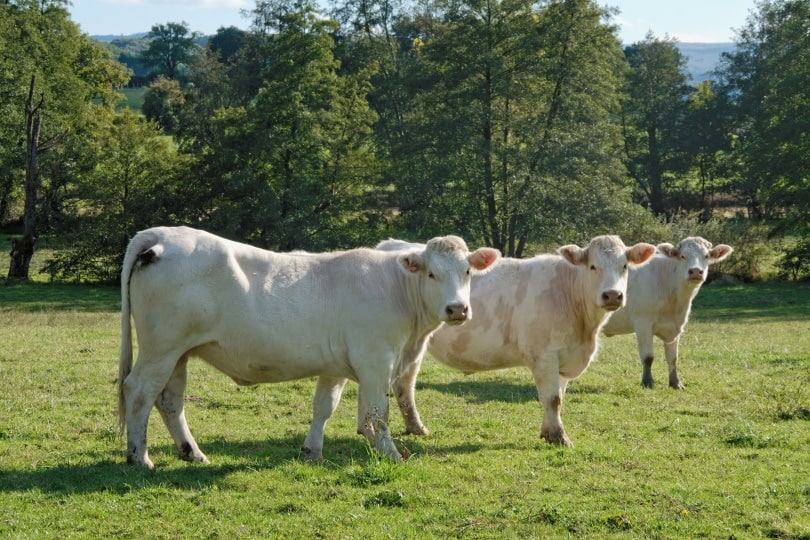The Charolais cattle breed is a large, light-colored taurine cattle breed developed in France for draft purposes. These cattle are used for beef production and crossbreeding to enhance the growth and muscularity of other beef cattle breeds.
Charolais cattle are found in every country that produces beef and are known for their cream or white coloring, horns, and massive size. These same characteristics made them popular when they were first introduced.

Quick Facts About Charolais Cattle Breed

| Breed Name: | Charolais |
| Place of Origin: | Charolles, France |
| Uses: | Beef, dairy, draft, crossbreeding |
| Bull (Male) Size: | 2,200 to 3,600 pounds |
| Cow (Female) Size: | 1,500 to 2,600 pounds |
| Color: | White or cream with pale pink noses and hooves |
| Lifespan: | 15–20 years natural lifespan, shortened by farming |
| Climate Tolerance: | All; hardy and tolerant of cold and heat |
| Care Level: | Low maintenance |
| Traits: | Rugged, hardy, docile, muscular |
| Production: | Beef, milk, offspring |
Charolais Cattle Breed Origins
The Charolais cattle breed is one of the oldest of the French cattle breeds. Considered of Jurassic origin, the breed was developed in the district around Charolais in the 16th and 17th centuries. With new historical evidence, these cattle may have been around as early as 878 A.D.
After World War I, a young Mexican industrialist of French ancestry brought his Charolais cattle to a ranch in Mexico. From there, they were brought to the US in 1934. The breed gained popularity for its size and beauty, leading to a demand for purebred Charolais.
In the 1940s and 1950s, the breeders established the American Charbray Breeders Association and the American Charolais Breeders Association, which created strict standards for the breed. Now, the associations are merged into the American-International Charolais Association.

Charolais Cattle Breed Characteristics
Charolais cattle are among the heaviest of cattle breeds. Bulls may weigh between 2,200 and 3,600 pounds, while the cows weigh between 1,500 and 2,600 pounds. Most Charolais cattle are massive and have horns, though selective breeding has created hornless individuals. They usually have a docile temperament.
Though crossbreeding may produce dark or red coloration, the typical Charolais bull or cow will be white or cream-colored with a pale pink nose and hooves. While light cattle are harder to keep clean for showing, it offers an advantage in hot, sunny weather. These cattle are less affected by the sun and heat and continue to eat and gain weight better than darker cattle.
Charolais Cattle Breed Uses
Like other continental and European breeds, Charolais cattle are raised for beef, dairy, and draft uses. The muscular cattle are capable of hauling heavy loads and serving farm work needs, though they’re most valuable for beef production and breeding purposes.
With the crossbreeding potential, Charolais may be used as a terminal crossbreed. A bull or cow can breed with another beef cattle breed and produce calves with significant growth and muscularity.

Charolais Cattle Breed Appearance & Varieties
The typical Charolais is white with a pale muzzle and hooves, horns, and a long body. Some breeders produce black or red animals, however. The cattle are medium- to large-framed with a short, broad head and body.
Prized for its muscularity, the Charolais is an excellent beef cow and demonstrates impressive growth capabilities and cut-out values. Ideal cuts are well-suited to fattening up.
Population/Distribution/Habitat
As a long domesticated breed, Charolais cattle can be found in virtually any cattle-producing country, including the US, Mexico, Australia, the UK, and most of Europe.
According to the Food and Agriculture Organization of the United Nations, Charolais is the second-most numerous cattle breed in France after the Holstein. The Charolais is a world breed and is found in 68 countries. The worldwide population is estimated to be 730,000, with the largest populations in the Czech Republic and Mexico
Another beneficial feature of the Charolais breed is that it’s tolerant of cold winters and hot summers. It will graze on pasture that other animals can’t use efficiently, still gaining weight and muscle, and the rugged hooves allow it to traverse rough terrain. Because of this, the Charolais is a hardy animal that can thrive in diverse climates.


Are Charolais Cattle Good for Small-Scale Farming?
Charolais cattle have better longevity and growth potential than other beef cattle breeds. With good genes, a Charolais cow will produce impressive calves. Charolais are also suitable for crossbreeding with Angus and other cattle breeds.
In addition, Charolais last longer than other breeds. Some bulls are regarded as disposable and only have a few good breeding years. A solid Charolais bull can breed for 8–9 years before retirement. Because of these traits, Charolais can be used for both small-scale free-range farming and large-scale feedlot farming.
The Charolais cattle breed arose out of France in the 16th and 17th centuries but quickly rose to popularity for its size, coloring, and hardiness. Now found in every cattle-producing country, the Charolais breed is raised for beef and dairy, but offers a lot of value as a terminal crossbreeding animal that can add growth potential to high-maintenance herds.
You may also be interested in:
Featured Image Credit: Sue Nixon, Shutterstock
